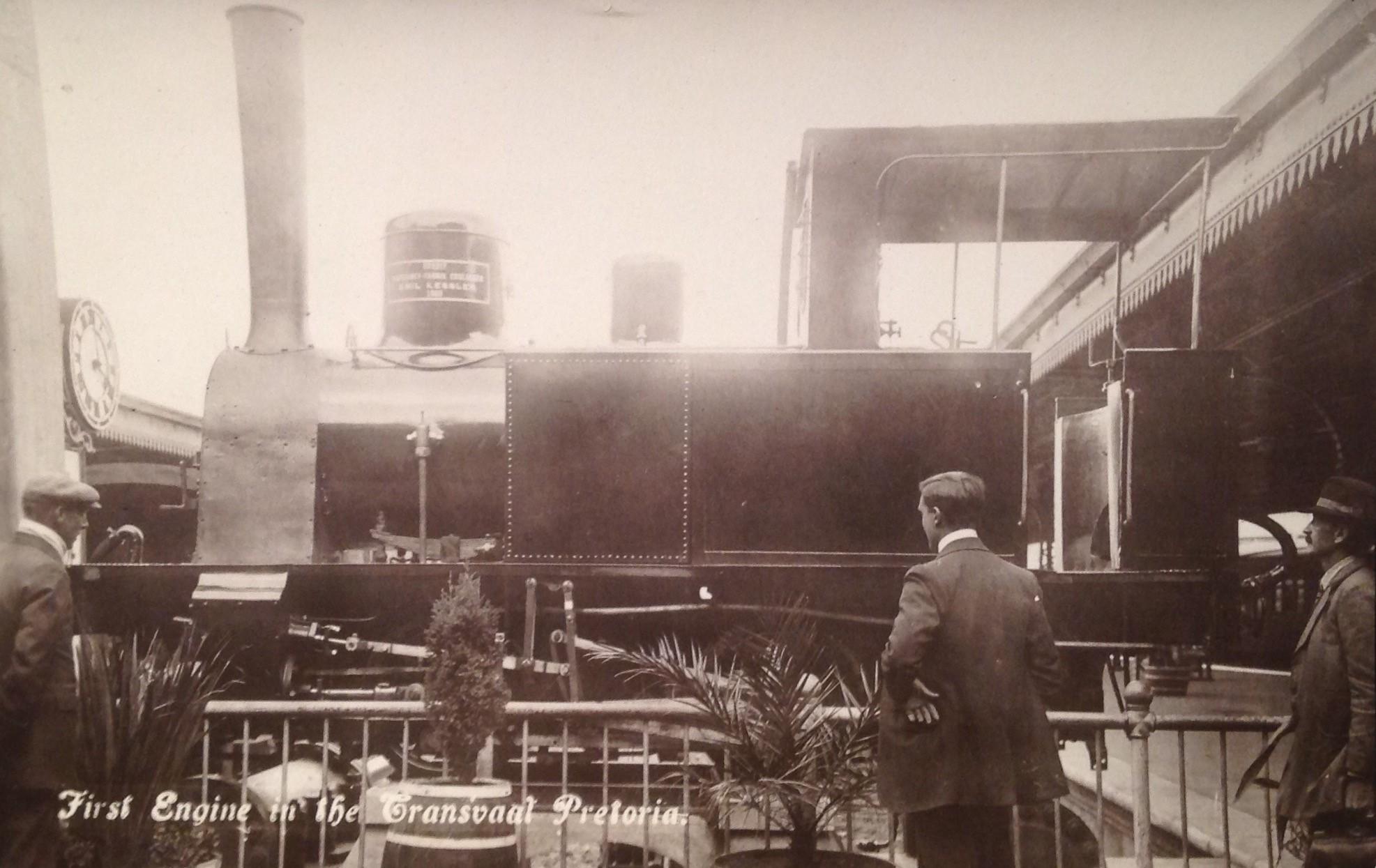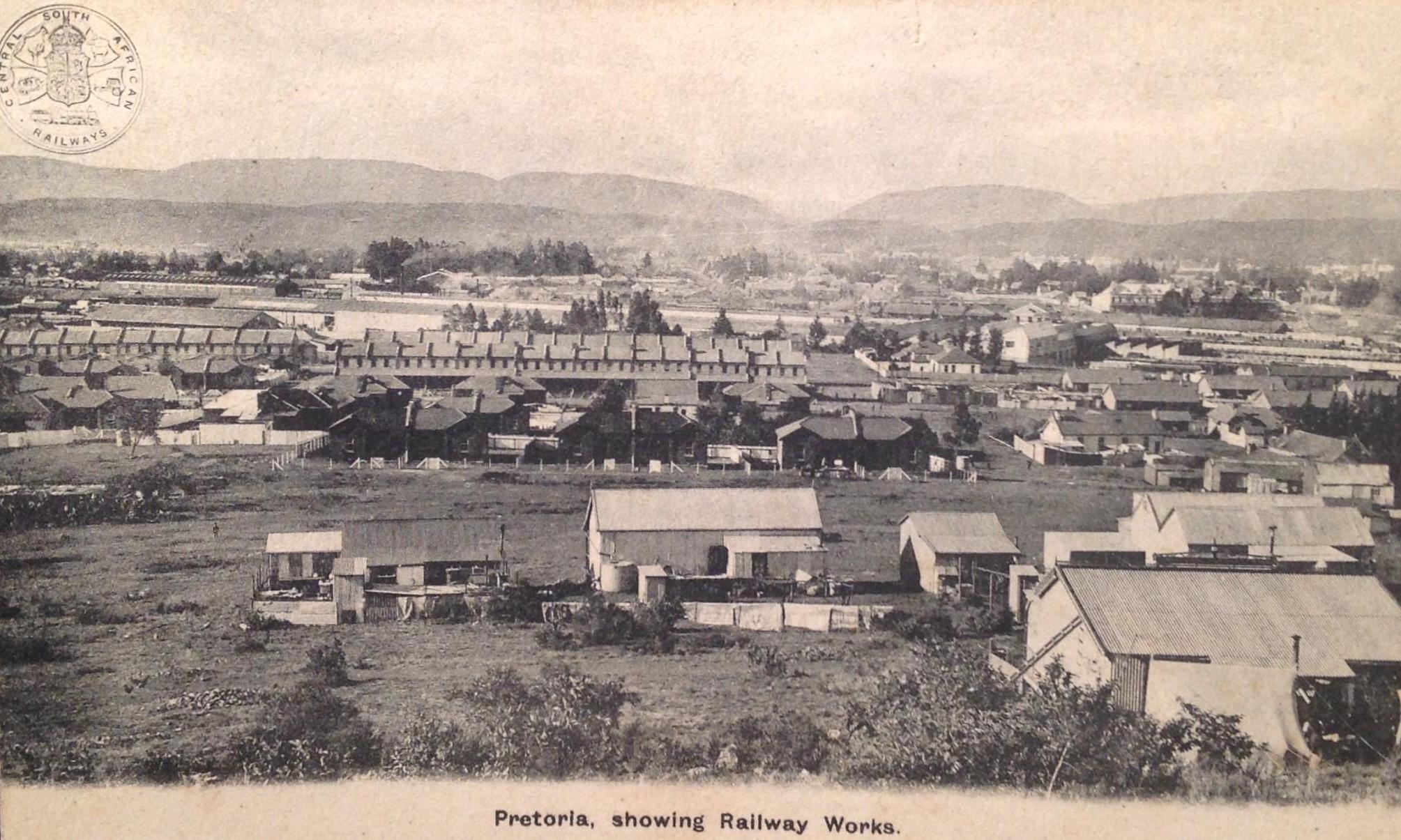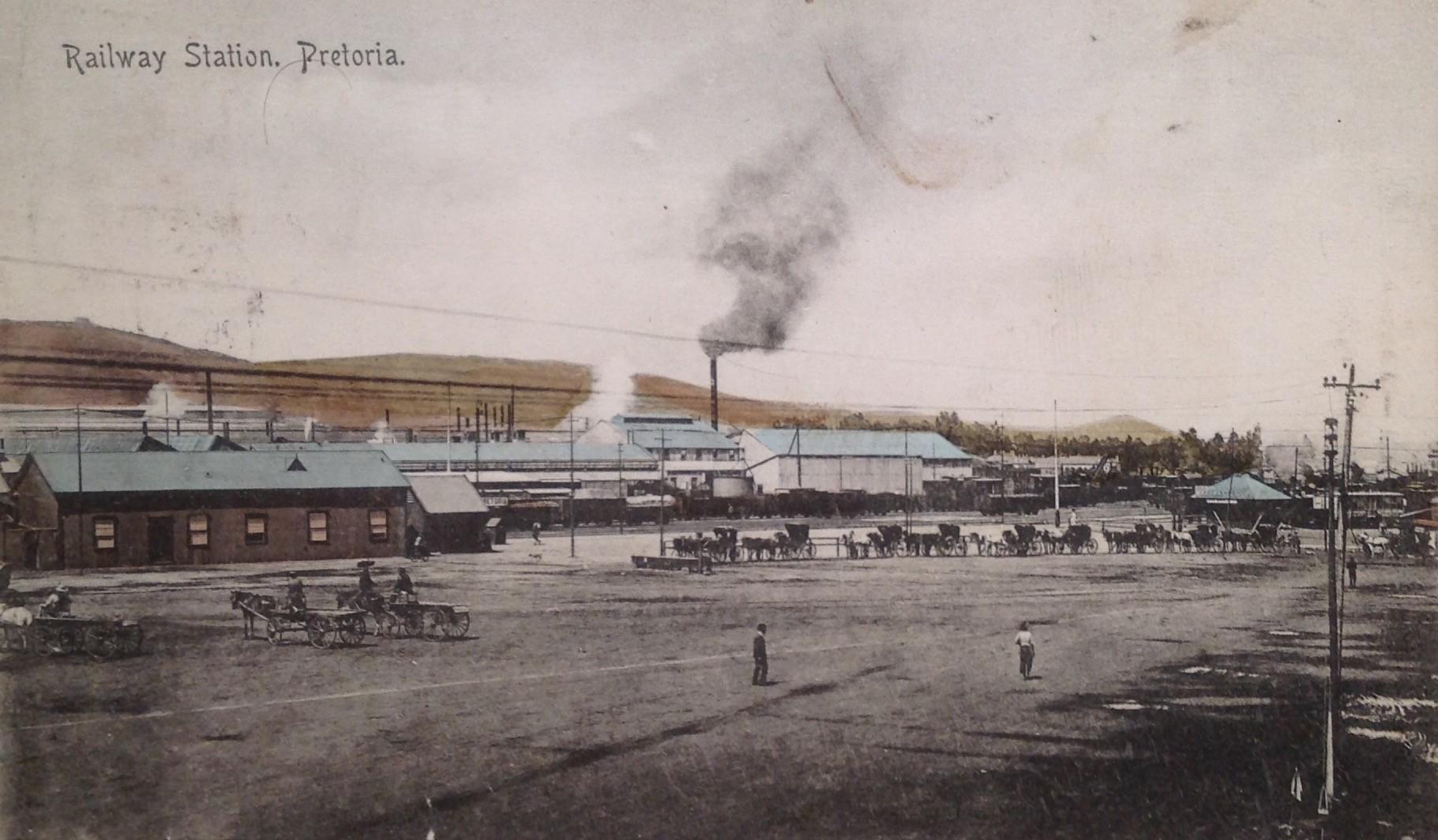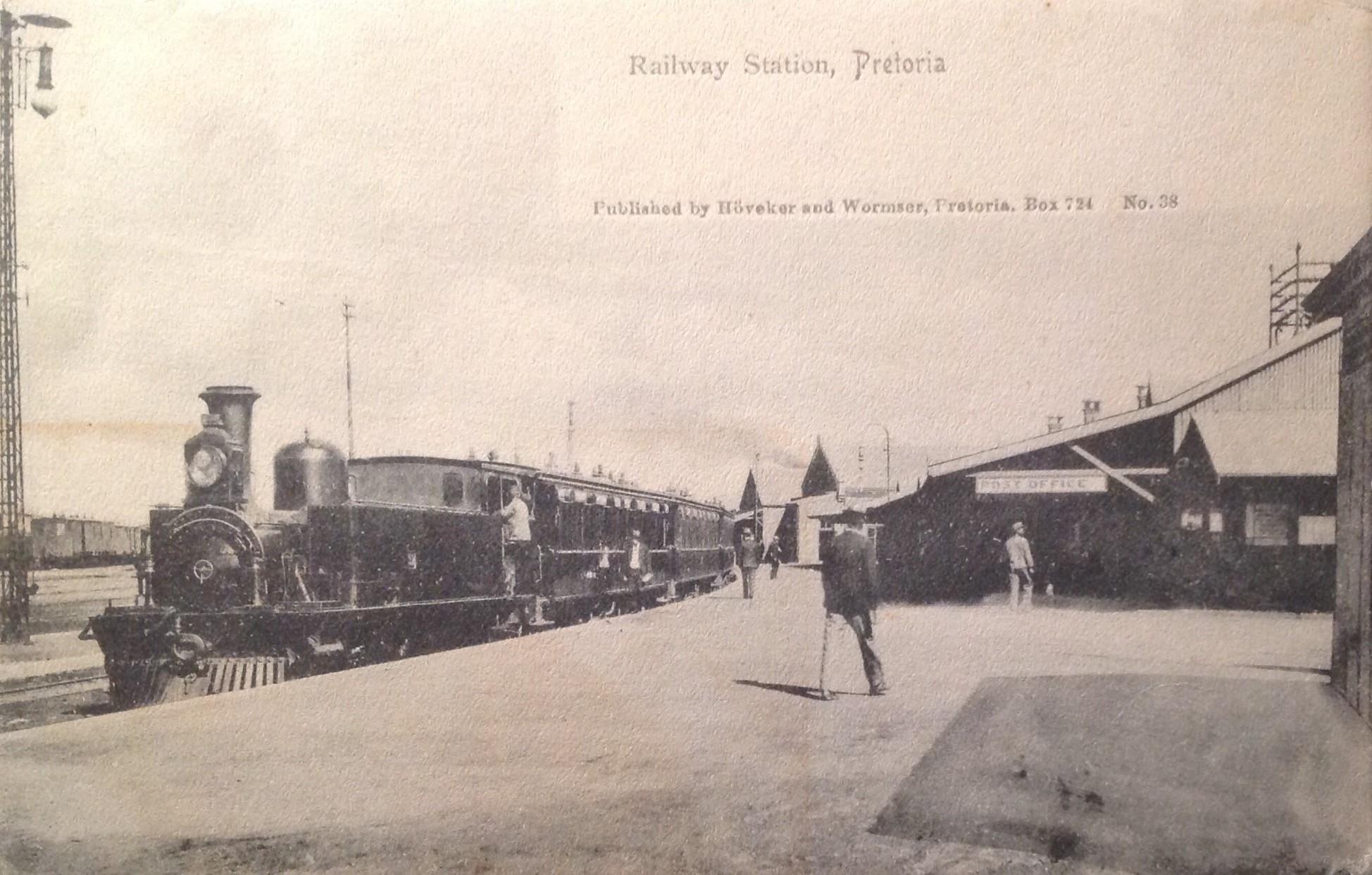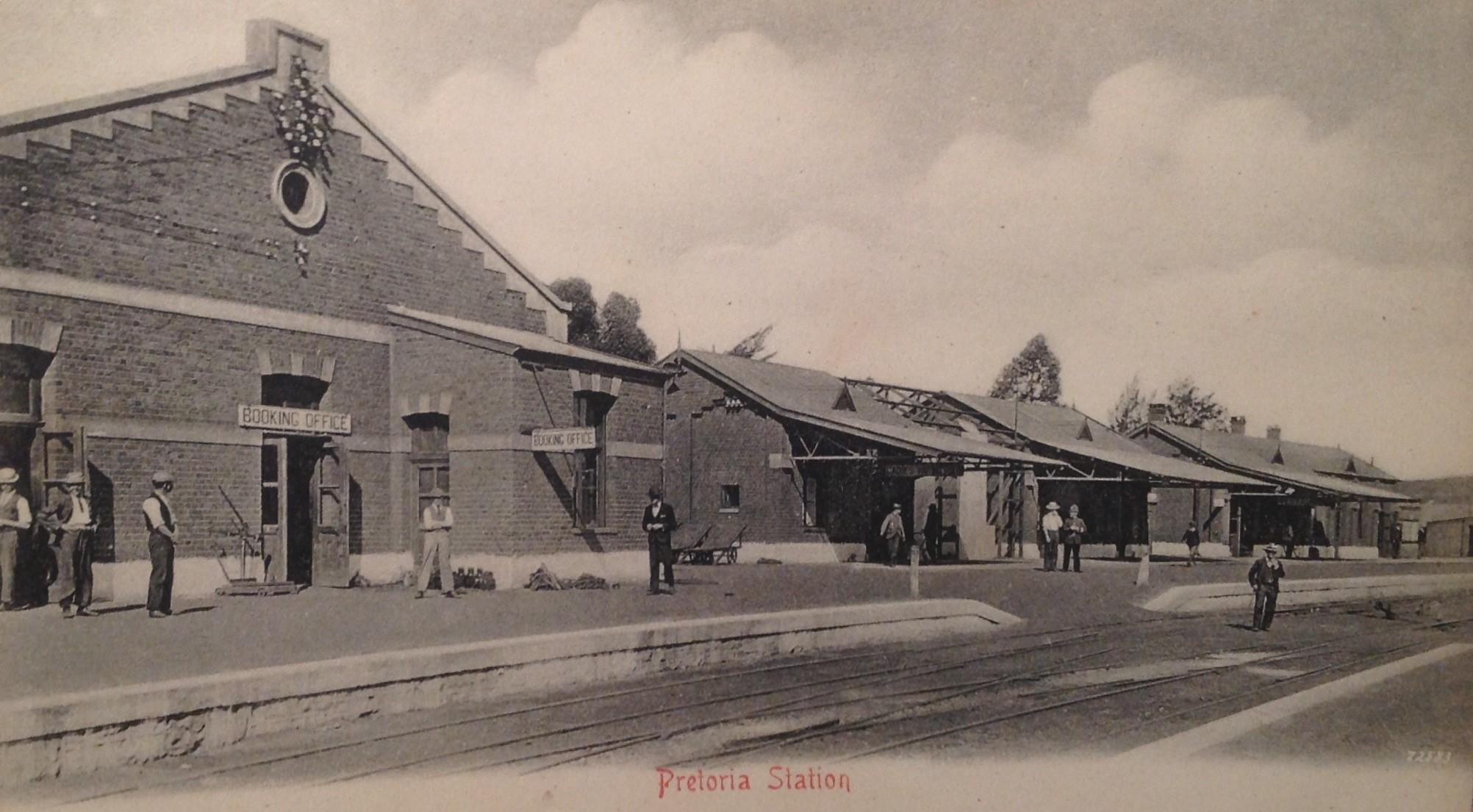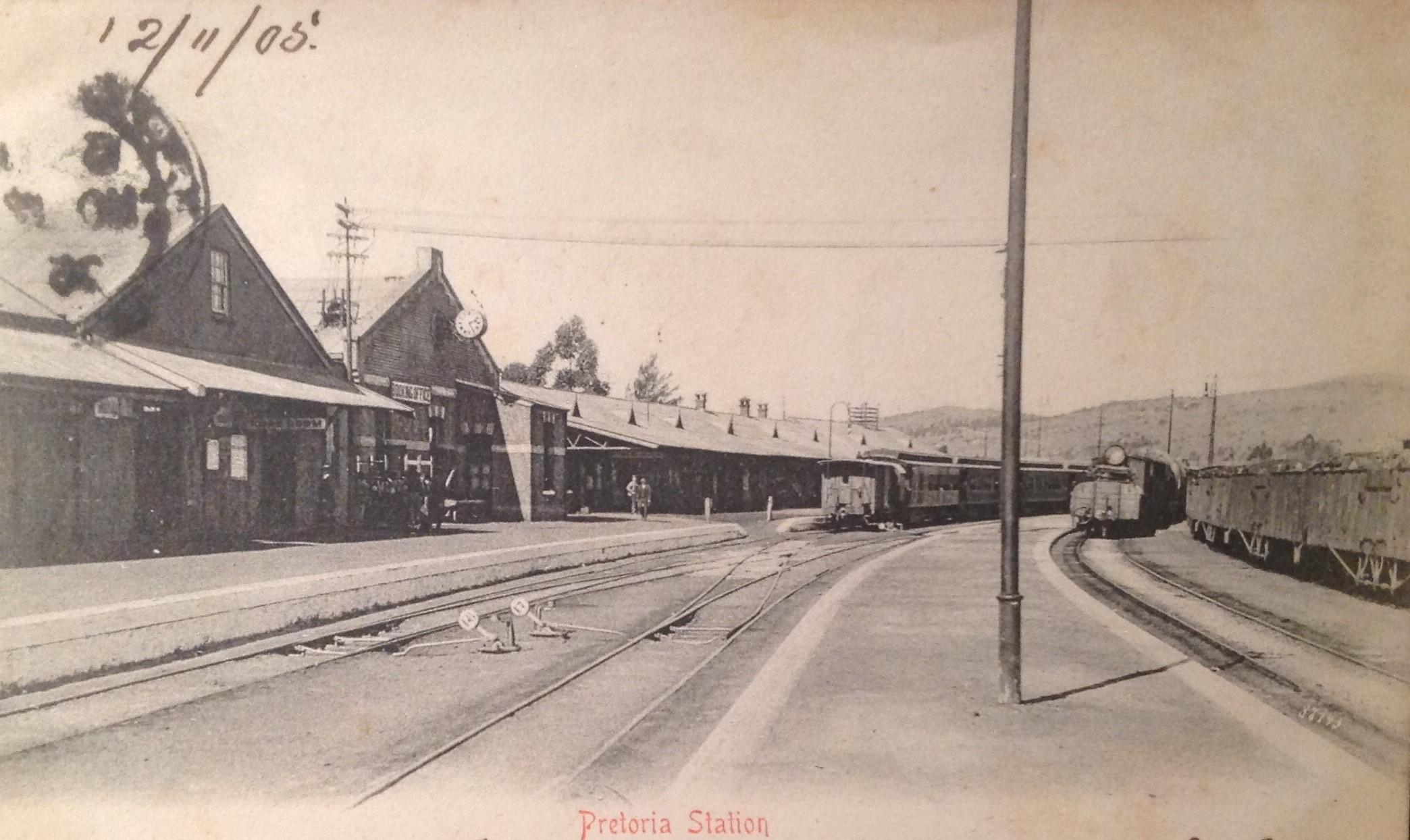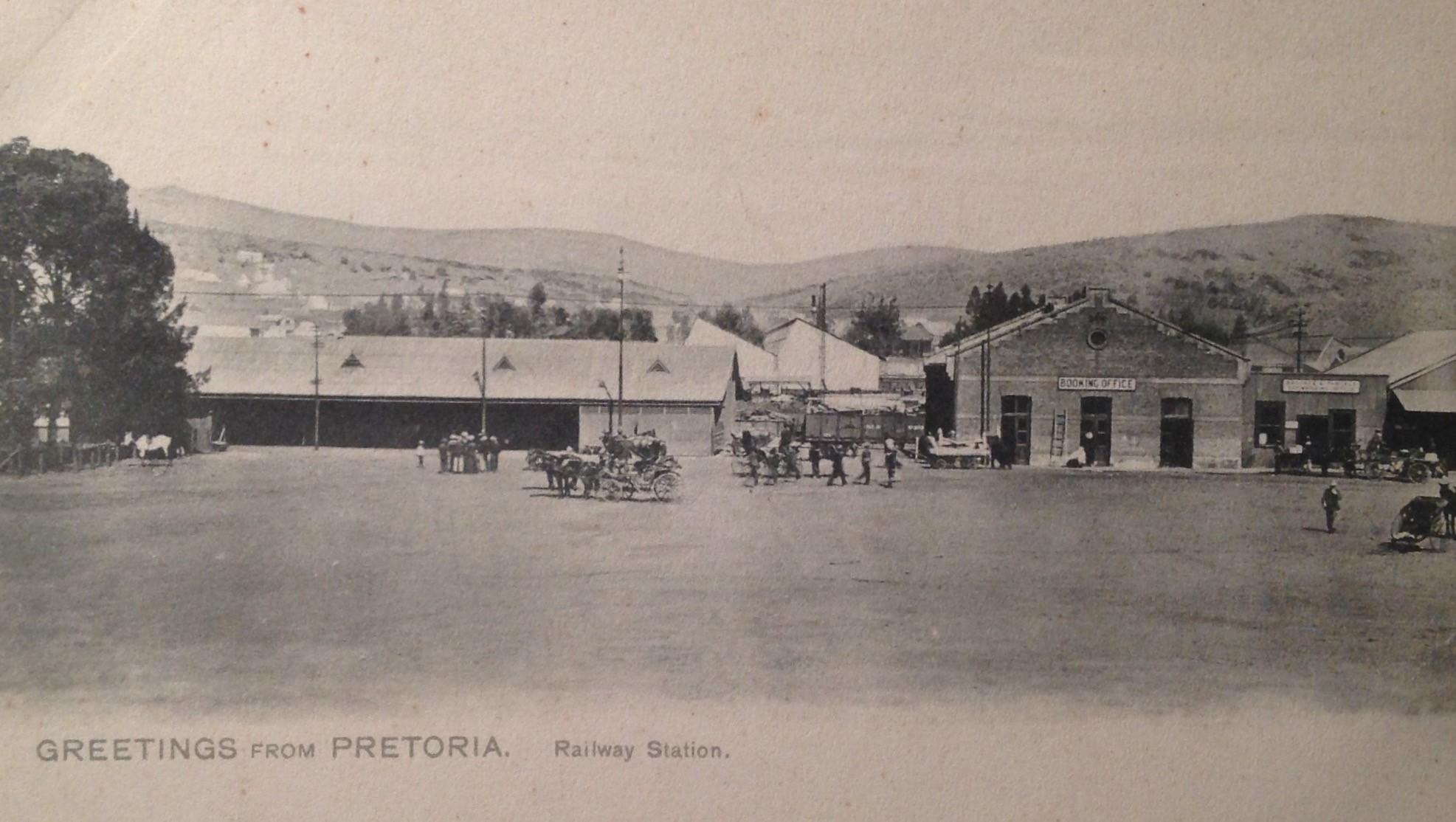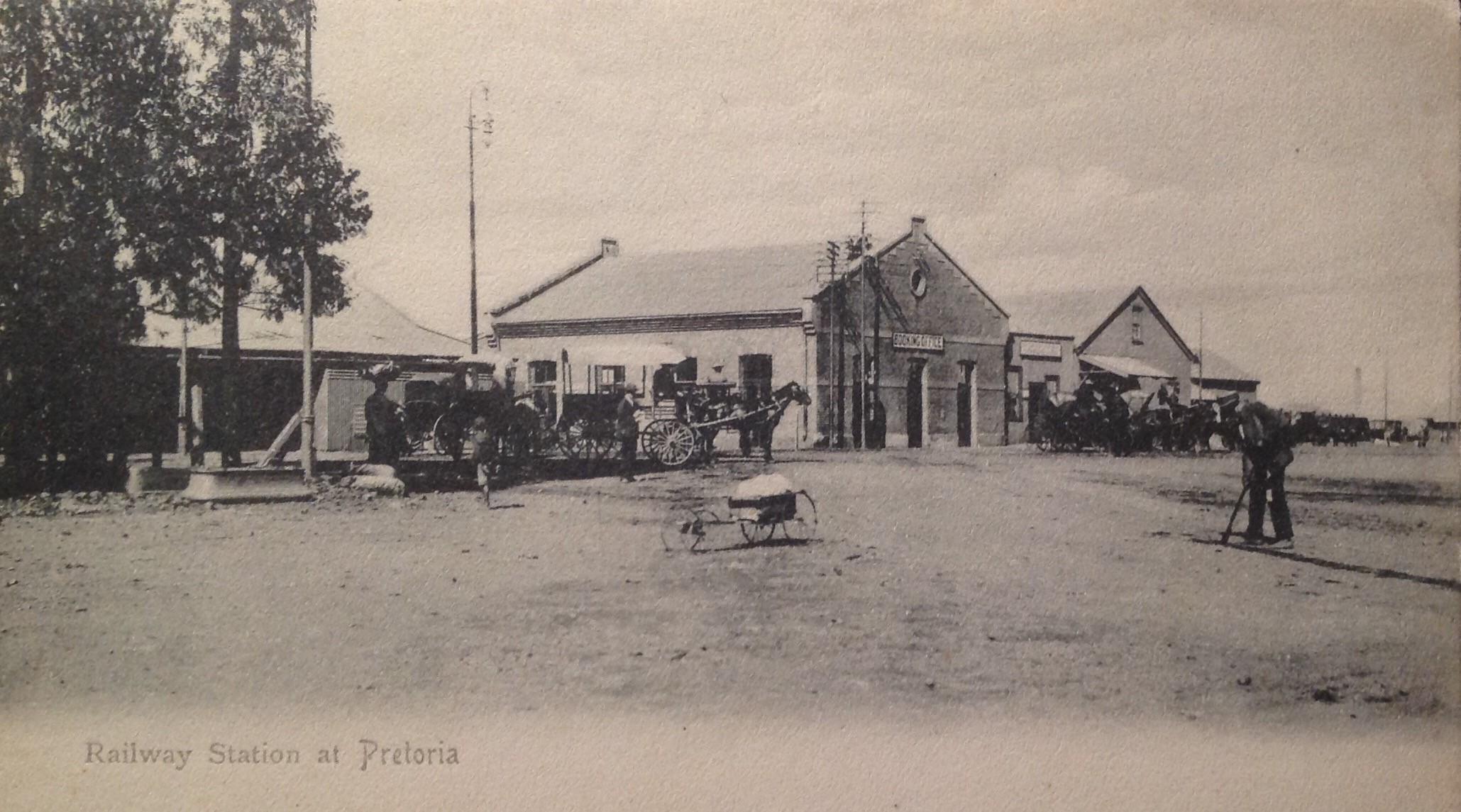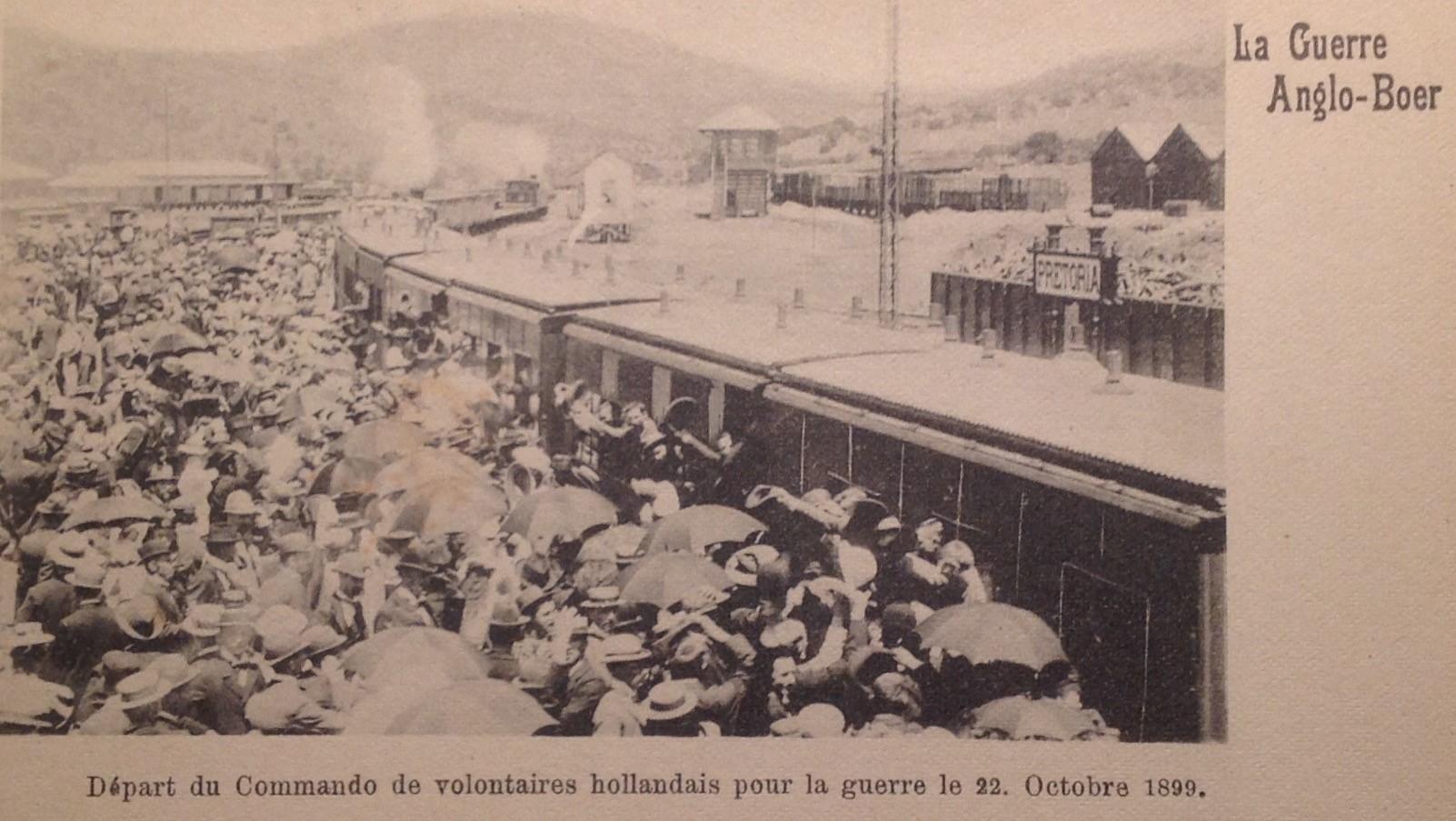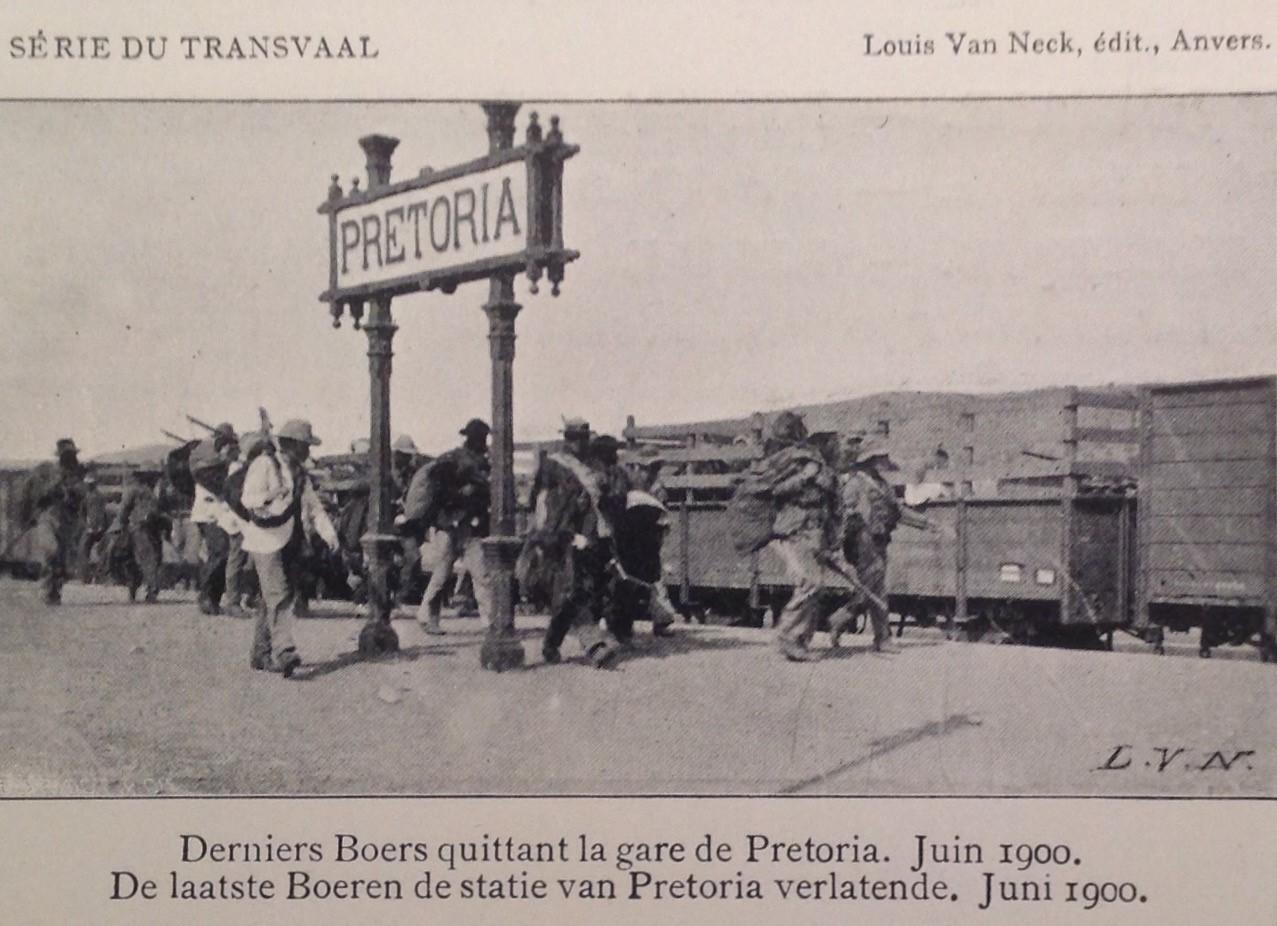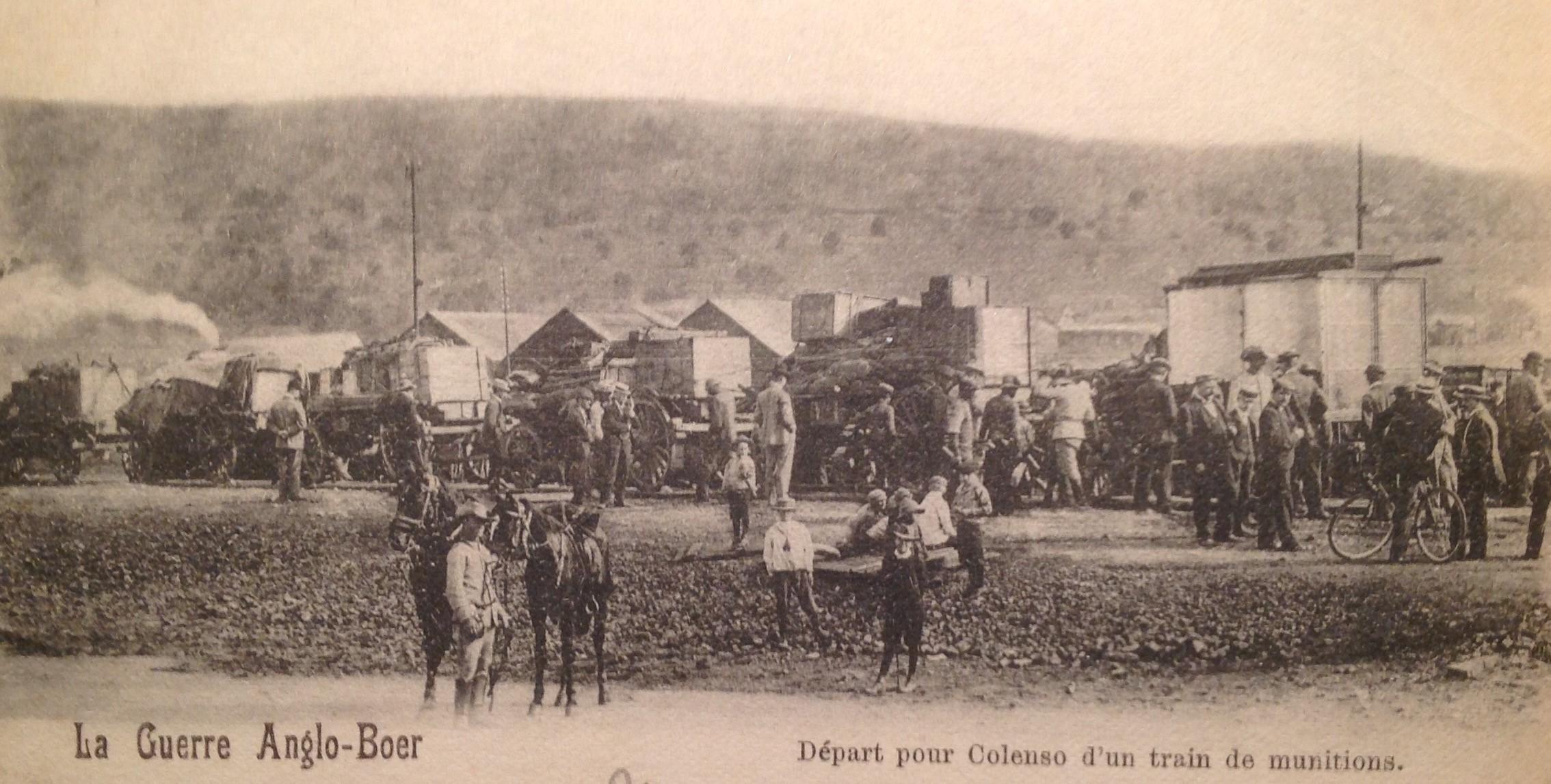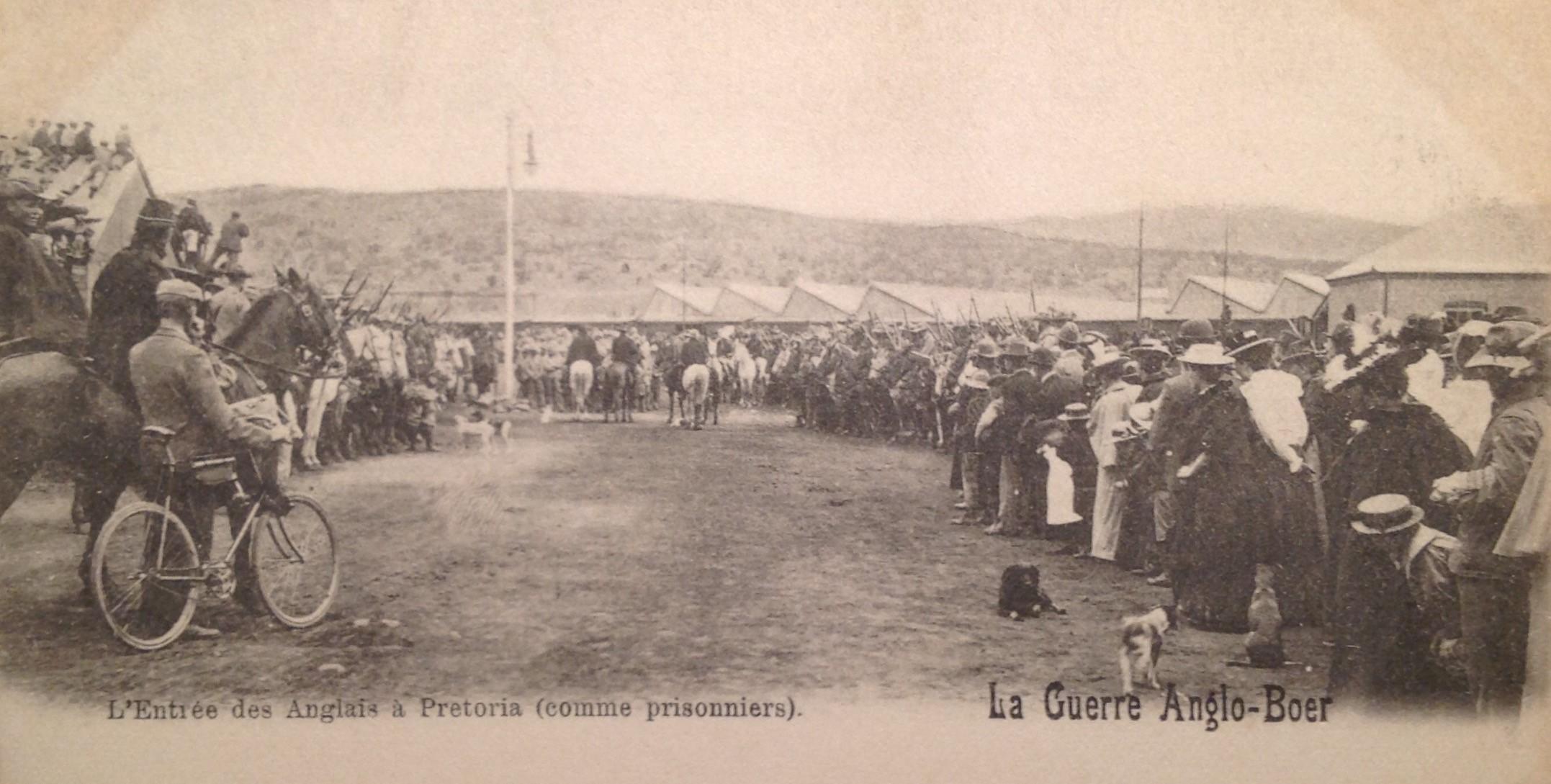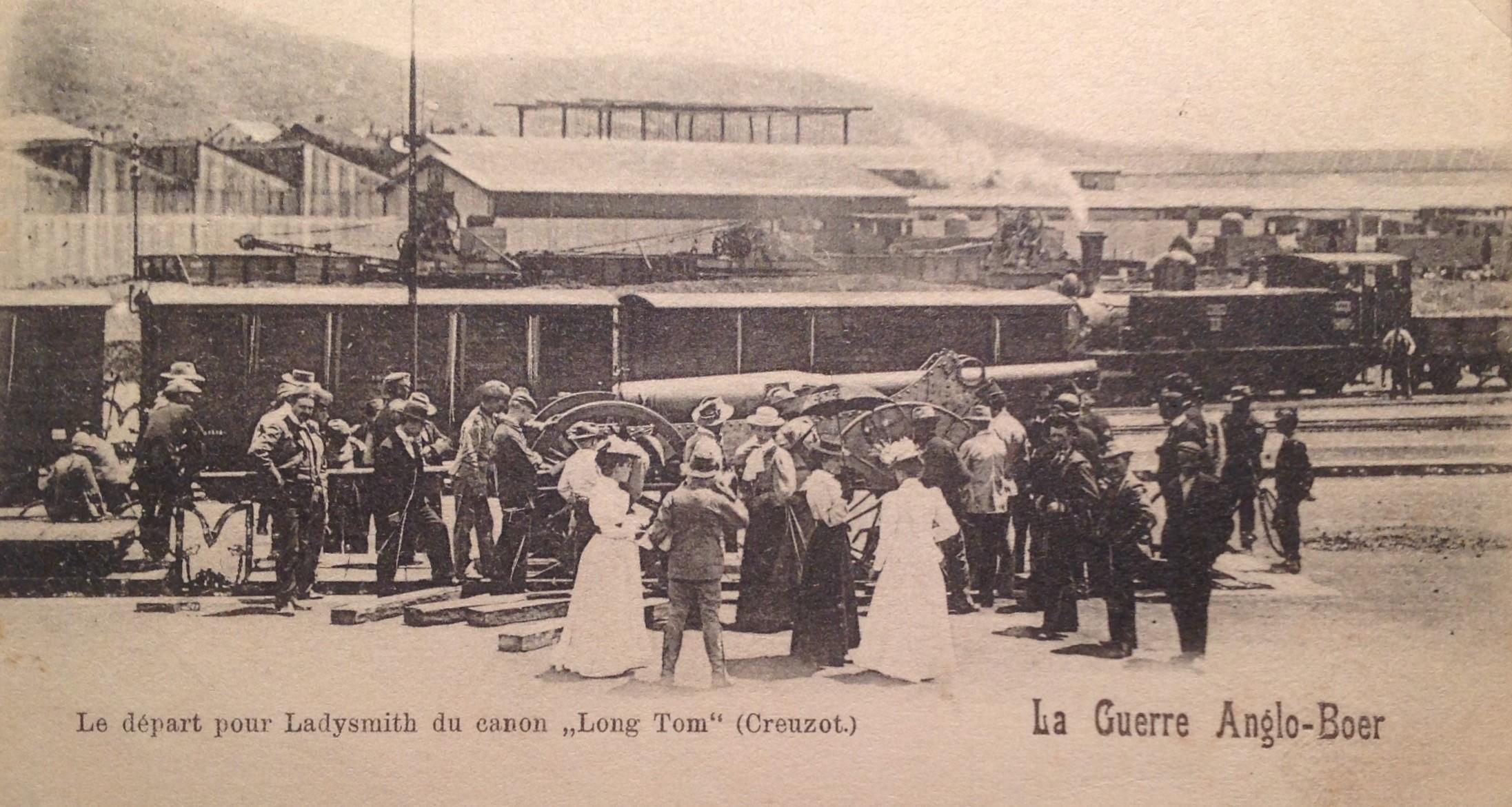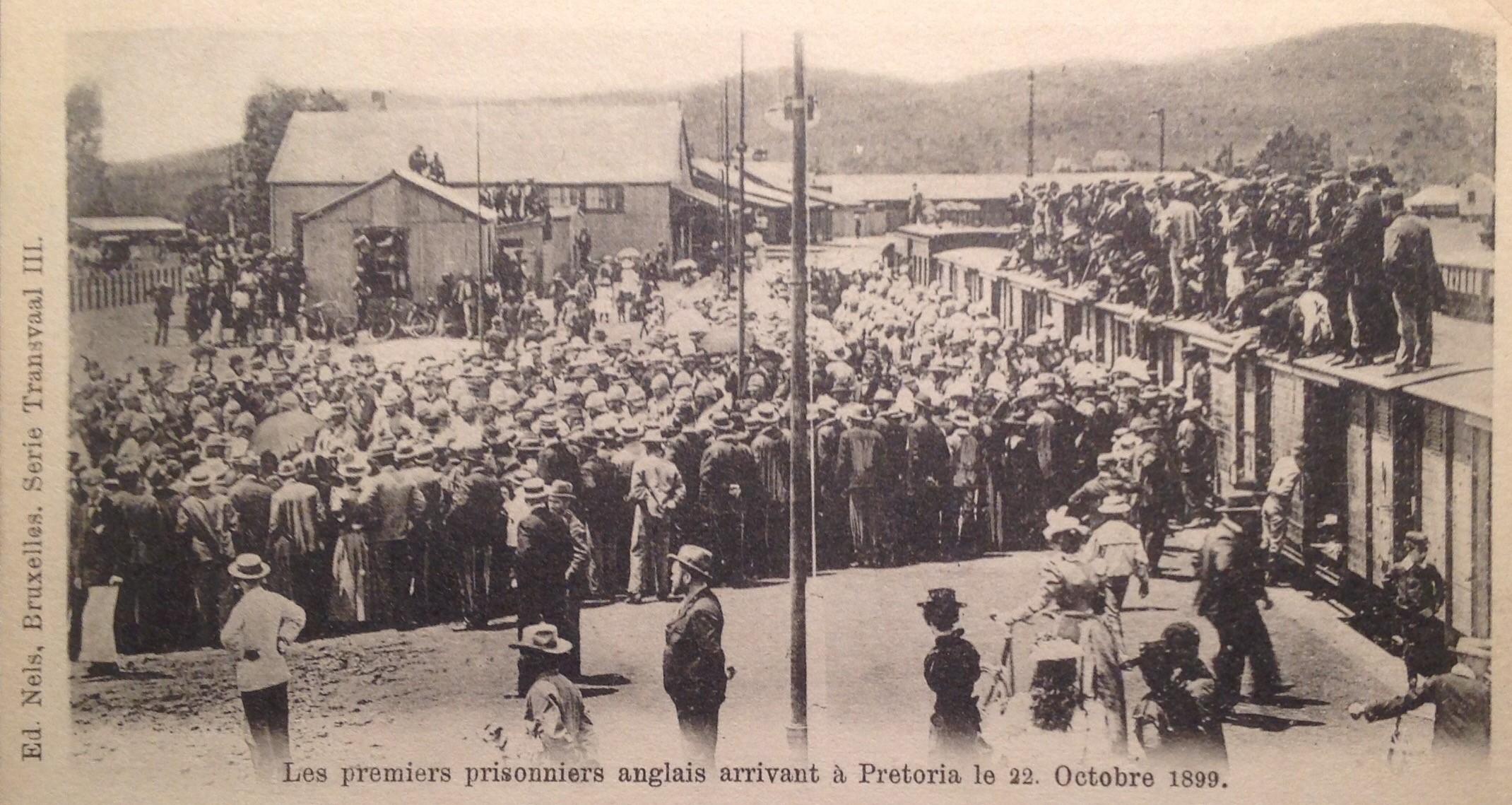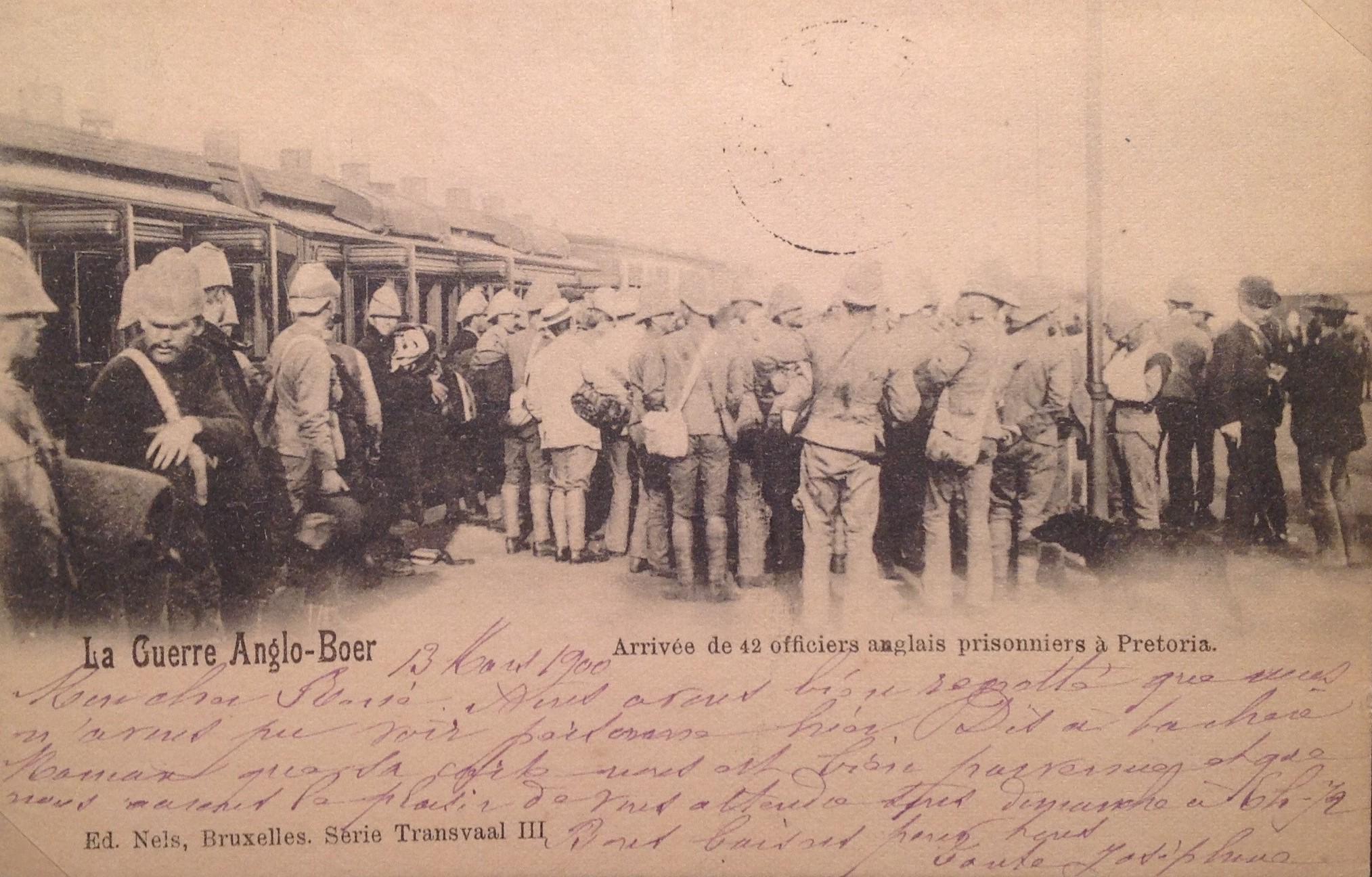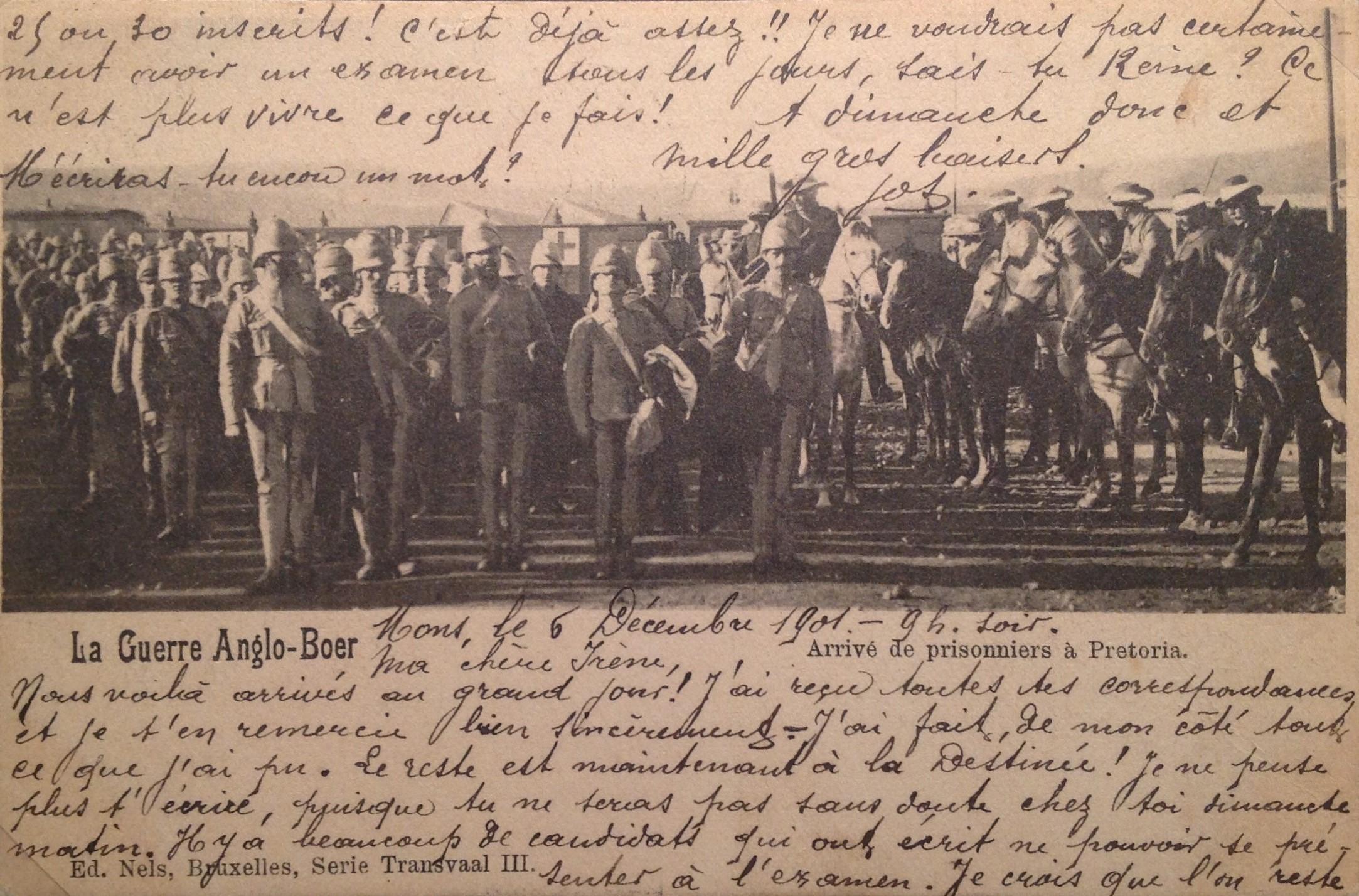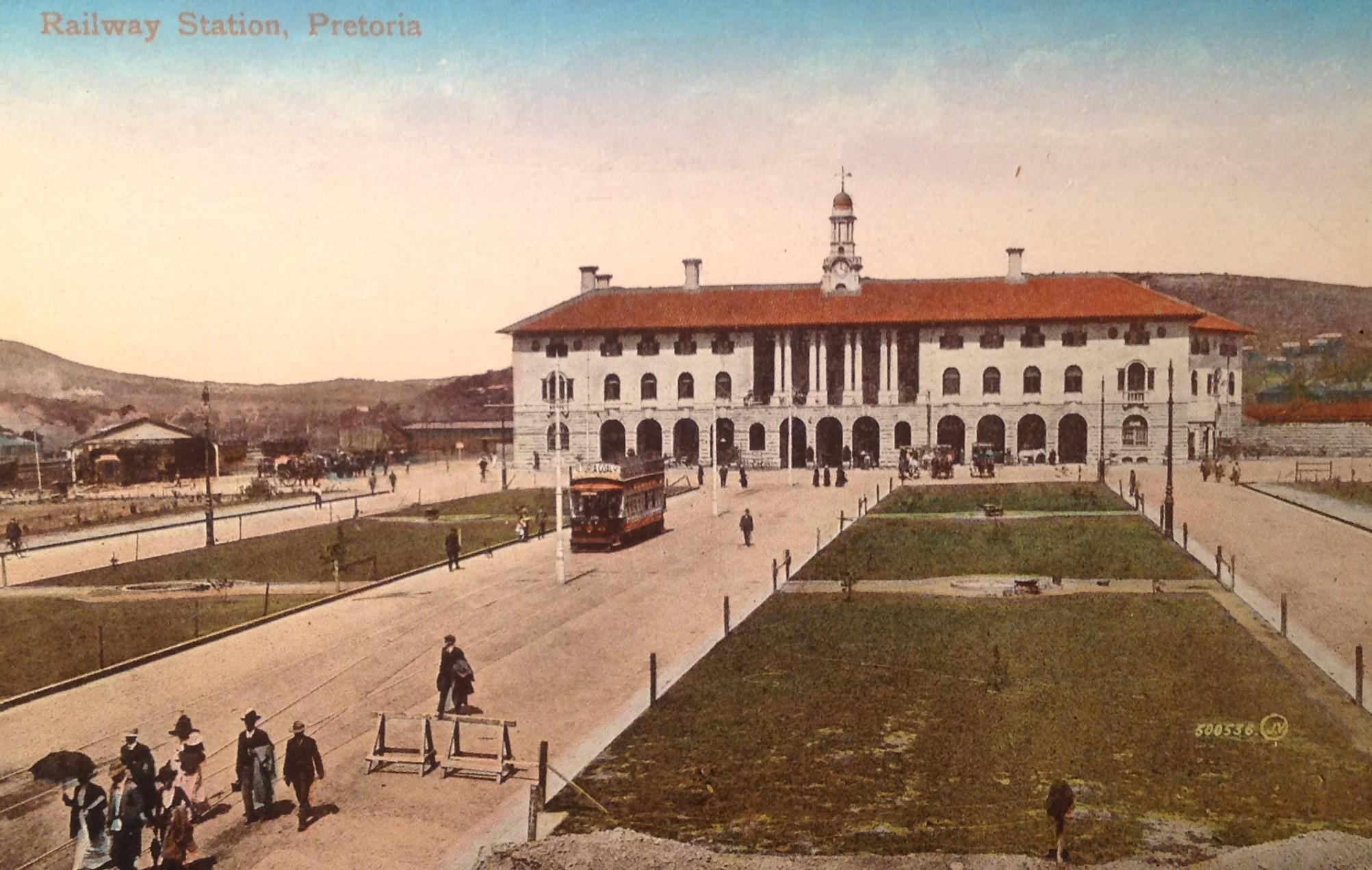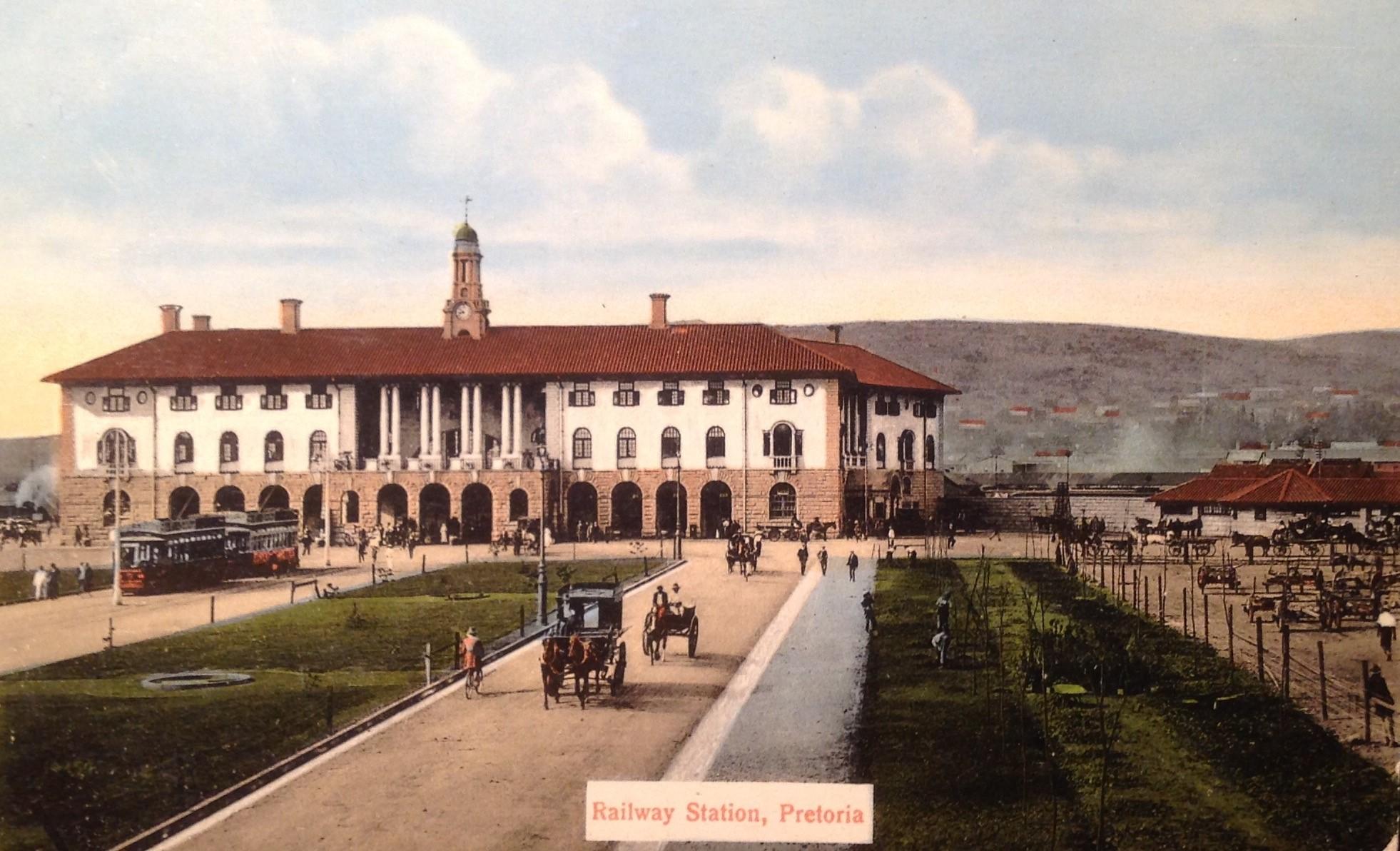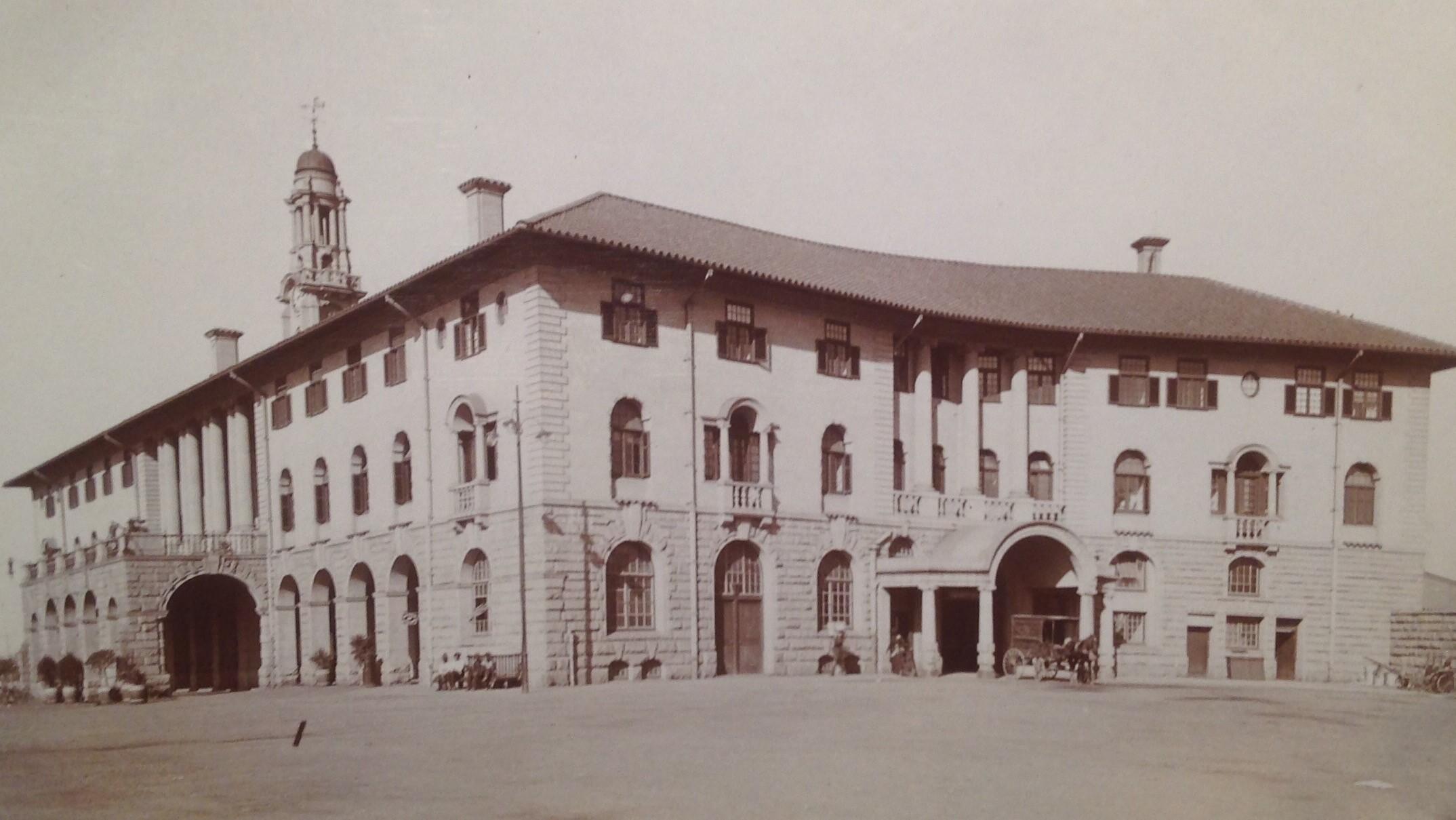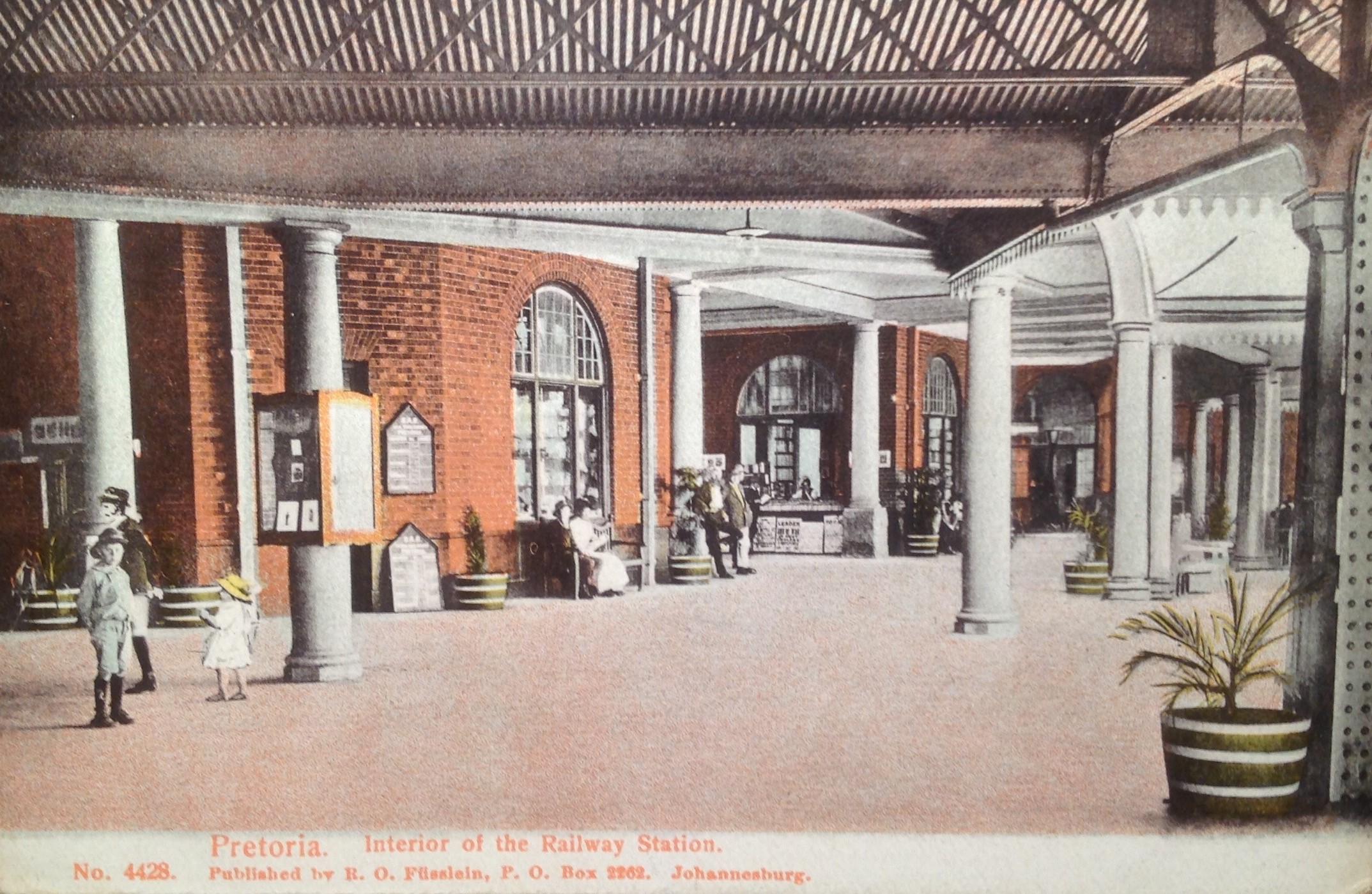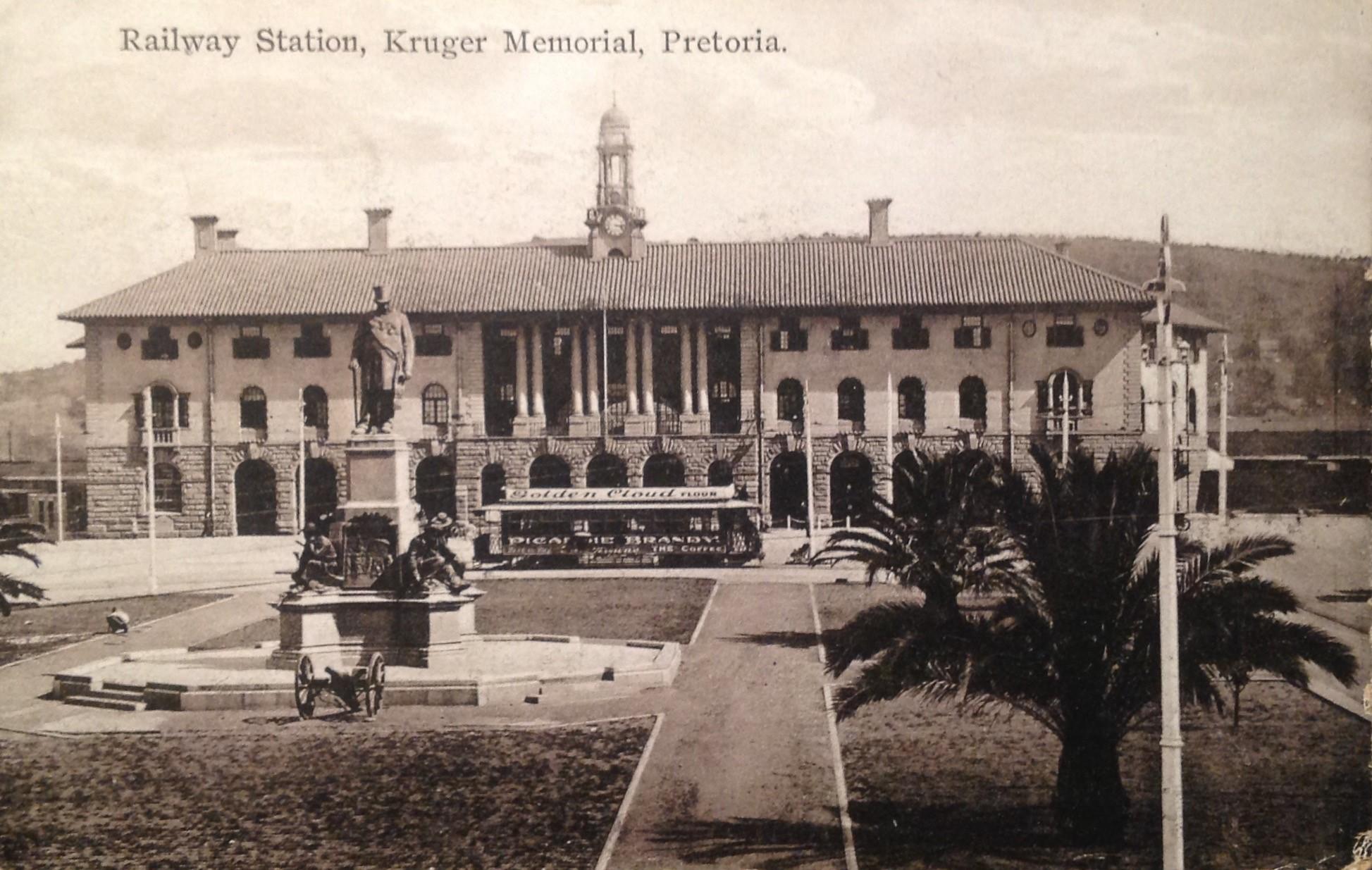
Disclaimer: Any views expressed by individuals and organisations are their own and do not in any way represent the views of The Heritage Portal. If you find any mistakes or historical inaccuracies, please contact the editor.
Combined with a brief reflection on Pretoria’s railway history, this article primarily sets out to reflect on the history of the two railway station buildings that were erected at the foot of a hill in Pretoria.
In support of this historical narrative, inclusive of key events that occurred at the Pretoria station during the Anglo-Boer war, this article’s main focus is on the visual history of the two station buildings (completed during 1892 and 1912 respectively), as portrayed on picture postcards over a 25-year period (late 1890’s to mid-1920s).
Whilst photographs of the Pretoria station also exist for the period between 1892 and 1899, picture postcards only became commercially viable in South Africa during the Anglo-Boer war period (1899 – 1902).
Introduction
Just south of young Pretoria, the first of two Pretoria station buildings, completed during 1892, was erected at the bottom of Time Ball Hill located at the end of Market Street (Paul Kruger street today).
But where does the name Time Ball Hill originate from?
During 1880 the Postmaster General, JA de Vogel, devised a scheme using a telegraph post whereby the arrival and delivery from the different mail routes into young Pretoria town could be signalled to Pretoria citizens. These signals varied from a suspended ball, a flag or a drum that was placed underneath the telegraph post (Andrews & Ploeger, 1989).
The hill, renamed to Salvokop around 1944, has also occasionally been referred to as Railway Hill.
It was thought that the name Salvo (meaning simultaneous discharge of 2 or more guns) had its origin from the two British military forts based on the hill during Transvaal’s first war of independence (1880 – 1881). These forts were Fort Tullichewan (or Tully as it was colloquially referred to) and Fort Commeline (Tomlinson, 1985).
A more plausible version is the one presented by Panagos (2005) who suggested that the name change came about at the time of the Second World War during which a saluting battery, based on top of the hill, provided a Royal salute upon arrival of the Governor General in Pretoria each year.
Freedom Park is today based on Salvokop.
A photographic picture postcard (Circa 1930s) showing the first locomotive in action in Transvaal (early 1890s) on exhibit at the Pretoria Station. Published by Pretoria based VanLeer.
The need to link Pretoria with a coastal port and the establishment of NZASM
From its earliest days the Zuid-Afrikaansche Republiek (ZAR) or Transvaal Republiek (established during January 1852), had planned a rail route to the Indian Ocean through Mozambique making it entirely independent of the British seaports on the South African Coast. This dream only materialised some 42 years later. The British annexation (1877 – 1881) was one of the reasons for the delay in the rail line finally being built. This line became known as the Eastern, or Delagoa line.
Delagoa Bay (Maputo today) in Lourenço Marques was the nearest harbour facility in neutral territory.
In the early days of South African railway construction, both the Cape Colony and Natal pushed ahead in building rail lines that would eventually connect with the biggest import city in the country, namely Johannesburg. The ZAR Volksraad however initially refused these two “foreign” lines to cross the Transvaal border before their own line to Delagoa Bay was completed.
The first step in the Delagoa Bay rail connection became reality when the NZASM (Nederlandsche Zuid-Afrikaansche Spoorwegmaatskappij / Netherlands South African Railway Company) was established on 21 June 1887 and granted a concession to build rail connection to the Portuguese Mozambiquan border (Cartwright & Cowan, 1978).
The discovery of gold on the Witwatersrand during 1886, however, preceded the establishment of rail activity between Pretoria and Delagoa Bay.
Gerrit Adriaan Arnold Middelberg, director to NZASM, arrived in Pretoria during 1890 in order to resolve a rail concession that prevented the building of the rail line between Lourenço Marques and Pretoria. At the time, Middelberg resided in the NZASM house in Market street (near Burgers Park). This building was sadly demolished during 1958.
Following the intervention of President Kruger, the amended concession was approved on 25 June 1890. The NZASM eventually started constructing the line between Komatipoort and Pretoria which became fundamental to the economic development of the ZAR (Greyling, 2000).
Delays in building the Delagoa Bay line however continued and in the end President Kruger had to relent and gave both the “foreign” lines from the Cape and Natal the right of entry, resulting in the first train from Cape Town arriving at the Johannesburg station during 1892. On 16 December 1895, a few days before Jameson’s forces crossed the border, the Natal train left for Johannesburg (Cartwright & Cowan, 1978).
Other than the delays referred to above, the ZAR caught up within a relatively short period with the other parts of the country where rail infrastructure has been in place since the 1860s (de Jong, 1987).
Looking towards the north - In the foreground Pretoria’s railway works and railway employee residence with the railway station barely noticeable in the background. Visible on the top right of the image is Market street showing the distinct Victoria Hotel tower and the church on Church Square in the distance. Published by Central South African Railways. Circa 1908.
NZASM springs into action
Due to the Witwatersrand’s Goldfield having an immense need to be connected via rail, NZASM got the concession to build the Rand Tram between Boksburg and Johannesburg. The Rand Tram began by operating this 16-mile stretch where there were large deposits of coal (Cartwright & Cowan, 1978).
Rand Tram allegedly came about its’ name due to members of the Volksraad not approving of railway trains. The name Rand Tram therefore was a subterfuge that helped to provide at least one form of transport that moved faster than an ox-wagon.
This line, which was a test for the NZASM rail builders, began as an arrangement for transporting coal to the diggings carrying the heaviest traffic in the ZAR at the time. The builders passed with flying colours when the line opened on 17 March 1890. Described as one of the most successful exercises in railway construction in the Transvaal, NZASM was then awarded the contract to build the Southern line (Johannesburg / Elandsfontein) (Peacock,1955; de Jong, van der Waal & Heydenrych, 1988).
Although the NZASM head office was in Pretoria – the ZAR capital was only linked to Johannesburg, via Vereeniging (Southern line) during January 1893. For what it is worth, some 68 years after the first steam train ran in England (1825) (de Jong, 1994).
The two harbours of Lourenço Marques and Durban were eventually linked to the NZASM line through both the Eastern & South-Eastern lines respectively.
The building of the Eastern line became an epic in its own right following the lengthy construction time of nearly 6 years.
The 100 kilometres of track between Delagoa Bay and Komatipoort provided for its own unique challenges in that draining the vast swamps that surrounded Lourenço Marcques were required with a heavy death toll caused by malaria-bearing mosquitoes, dysentery and snake bites which all contributed in delays in completing this section of the rail line (Cartwright & Cowan, 1978).
On 1 January 1893, the Elandsfontein-Pretoria rail line (Southern line) was opened following the Elandsfontein-Viljoensdrif (Vaal river) opening during September 1892. Pretoria therefore became connected for the first time with Johannesburg (via Elandsfontein) which in turn connected to the Orange Free State and the Cape Colony (Peacock, 1955). Since the opening of the Southern line, there was a regular rail connection between Johannesburg and Pretoria. Early passenger rail services had trains depart from Pretoria daily at 6h10; 11h23 and 17h50 whilst trains arrived from Johannesburg 10h10; 16h42 & 23h05 (Peacock, 1955).
The Eastern line from Lourenço Marques, designed by a Portuguese engineer Machado, reached Nelspruit during June 1892. From 1893, the line was also being built from Pretoria. On 20 October 1894, the two parts connected at Balmoral.
On 2 November 1894 President Kruger applied the last bolt and on 18 November 1894, the Eastern line was open for the first passenger train. The Delagoa rail line officially opened on 1 January 1895 followed by huge festivities in Pretoria during June 1895 (Peacock, 1955).
During 1895, The Press printing works printed a one penny stamp to celebrate the opening of the Eastern line (Dunston, 1975).
Various direct and indirect rail connections into/from Pretoria were established over time. All these lines resulted in speedier transport of goods, agricultural products, post and passengers. On 1 June 1899 the NZASM line (from Pretoria) also became connected to the Pietersburg line.
During 1899 NZASM had 1147km of completed rail line with 230 locomotives, 238 coaches and 5230 trucks/wagons. In the same year NZASM employed 1770 Dutch citizens and ex-citizens, as well as 777 South Africans and 1615 labourers from some 26 different nations (Meiring, 1981).
This image, looking north-west, shows the railway workshops on the left with much activity, clearly divided from the formal station complex on the right – from where a passenger train has just arrived (or in the process of departing). The building just right of the trees, probably on Scheiding street, remains unidentified. Publisher Braun & Levy (no 2034) – Circa 1905.
Pretoria’s 1st railway station buildings (1893 to 1912)
When work started on the Elandsfontein-Pretoria section of the Southern line in August 1890, serious attention was given to the design of a station building for Transvaal’s capital. At the time however, the NZASM was in financial difficulties, which was probably the reason for the simple and inexpensive building designs. The designs were ready by 1891 and during July 1892 tenders were called for the construction of a “station building and other buildings” (de Jong et al, 1988).
Pretoria’s first station was completed to receive the first train from Elandsfontein Junction (Southern line) during December 1892 (Andrews & Ploeger, 1989).
Pretoria’s initial station buildings, simple and rather unprepossessing, were completed in the course of 1892 and formed part of a complex of buildings on the extensive Pretoria railway yard which stretched from Potgieter to Andries Street and from Scheiding street to Salvokop. These simplistic building structures were established in spite of the fact that Pretoria was not only the ZAR’s capital, but also the seat of the NZASM’s Transvaal headquarters and the terminus of two important lines, namely the Eastern line from Delagoa Bay and the Southern line from Vereeniging and Elandsfontein (de Jong et al, 1988).
Pretoria station looking south west – this shows the bottom end of the station complex with the railway works in the background. The chimney and larger white building in the centre of the image would be the boiler house and foundry. The two buildings in the foreground formed part of the railway station complex - It is not known what their purpose was. They were erected after the initial 5 building station complex was built. Note the horse carriages awaiting passengers for onwards transportation. Publisher P.S. & C (no 19/38) – Circa 1905.
Train ready for departure from the Pretoria station. The post office housed in the building on the right seemingly used to be the parcel office prior to it moving between the booking office and refreshment room. In the background the larger booking office and refreshment room complexes can be seen. Pretoria based publisher Höveker & Wormser (No 38) – Circa 1905.
Picture postcard showing the Pretoria station complex (Circa 1903). The building to the immediate right of the booking office is the ladies waiting room. This image is unique in that it clearly shows construction in progress placing the initial three stand-alone structures to the right of the booking room under a single roof. Note that the booking office at this point still does not have a clock mounted outside – See image below where the clock is included. Publisher Sallo Epstein.
The booking office now shows the external mounted clock – which confirms that the photograph was captured at 14h25 in the afternoon. On the left the refreshment room followed by the booking office can be seen. In between these two buildings would be the smaller parcel and forwarding office. Card published by Sallo Epstein – Circa 1905.
Apart from the station buildings, there were several huge workshops, sheds, stores, a roundhouse, a foundry and about thirty residences for staff. Historical photographs indicate that the area was fenced off and treeless, creating a typical industrial atmosphere with all the corrugated iron sheds, waggons, locomotives and construction material rather haphazardly laced (de Jong et al, 1988).
Instead of one building, Pretoria’s initial station complex consisted of five separate structures next to each other. Starting from the western point, the first building started off as the parcel office, then followed a service building, a ladies’ waiting room, the booking office/general waiting room and finally the refreshment room (de Jong et al, 1988).
These initial buildings were of brick and covered with low-pitched iron roofs. Whilst the main building, the booking room, had an official appearance and featured some embellishments in colourful application of red brick and white sandstone, all other buildings had extended roofs which created a residential or commercial impression. Only the side walls were decorated with stepped brickwork (de Jong et al, 1988).
Although the station complex started off with these 5 buildings, a number of changes were made during the 20-year existence of the complex. The first three standalone buildings to the west of the larger booking office were merged to become a larger single unit. The initial parcel office seems to have become the post office with a corrugated iron baggage and parcel forwarding office erected between the booking room and the rest room.
Some additional structures, not typically seen on all photographs, also arose further west and east of the initial 5 building structured station complex. Further research will need to confirm their purpose.
All these earlier structures stood slightly to the west of the current station building (second building complex). To negotiate the sloping terrain, the second building today stands at an angle to the main north-south thoroughfare.
This collection of buildings served as Pretoria’s first station until September 1912, just short of 20 years, when the existing imposing edifice, designed by Sir Herbert Baker was officially opened. The first station buildings were demolished some years thereafter.
Looking onto the Pretoria station showing the railway works in the background. This image shows the corrugated iron parcel and forwarding office between the booking office and refreshment room on the right. To the left of the image, the completed merging of the initial three stand-alone buildings can be seen. Card published by Pretoria based publisher C. Basson (Circa 1905).
Looking onto Pretoria’s first station complex showing horse-carts lined up to transport passengers to town. The complex in the centre is the booking office, with the smaller parcel and forwarding office on its right followed by the refreshment room. It is not known what the function of the last building on the right was. The man in the front seems to be performing some maintenance with his three-wheeler wagon in front of him. Card published by German based Otto Leder.
Pretoria's 1st Railway station and the Anglo-Boer war (1899 to 1902)
Delagoa Bay became the link with the outside world during the Anglo-Boer war.
At the start of the war, all trains and railway lines plus the entire staff of the NZASM were placed under direct government control (under Commandant General PJ Joubert).
The NZASM workshops in Pretoria were fully involved in the military operations during the first months of the Anglo-Boer war. The workshops repaired guns, manufactured parts of ammunition and fitted out four complete hospital trains for wounded combatants (de Jong et al, 1988).
The first armoured train, built at the NZASM workshops, left the Pretoria station on 28 September 1899 (Theron, 2000).
Prior to the British invading Pretoria, all civilian passenger traffic to Natal was stopped and NZASM trains were loaded with rifles, wagons, ammunition and food destined for the front (Theron, 2000).
Due to citizens electing to leave town just prior to the war being declared, the Pretoria station experienced a significant increase in activity at this time. Citizens even competed for seats on open coal trucks. The use of passenger rail shot sky high during October 1899, when some 97 470 passengers fled using various Transvaal stations (Pretoria included) as their departure point. This was up from 33 521 passengers the month before (Theron, 2000).
Anglo-Boer war: Belgian produced picture postcard showing Dutch Volunteers departing from Pretoria station on 22 October 1899. War related activity at the station regularly attracted large local crowds.
Anglo-Boer war: Belgian produced picture postcard showing the last of the Boers leaving Pretoria during June 1900. It is assumed that the elaborate pillars on which the Pretoria sign was mounted were made from cast iron.
Anglo-Boer war: Belgian produced picture postcard showing ammunition destined for Colenso in the process of being loaded at the Pretoria station. Note the four boys in the centre of the image looking directly at the photographer.
Between September 1899 and June 1900, the station was also the main departing point for ZAR burghers and other soldiers in support of the ZAR cause. The first group of burghers left the station for the front on 28 September 1899 (Theron, 2000). Large, excited crowds were also present at the station to witness burghers departing for the front.
In the period from 29 September until 10 October 1899, apart from transporting 8369 men to the front, Pretoria also saw 5381 horses, 398 wagons, 1907 oxen, 1525 tons of goods, 8 large guns and 93 tons of ammunition being transported from the station (Theron, 2000).
Critically wounded men were also transported from the front back to Pretoria by a special train service known as Vliegende Ambulancetrein (Flying Ambulance Train) (Theron, 2000).
British prisoners of war started arriving in Pretoria as early as 23 October 1899. This caused a stir among Pretoria citizens, who flocked to the station to stare at the prisoners. President Kruger apparently issued orders that there was to be no jeering or unpleasantness from the Transvalers something the citizens seemed to have heeded (Theron, 2000). By 11 November 1899, some 1418 British prisoners of war had arrived in Pretoria, via the station. The curiosity of the local onlookers was so intense that they even climbed on top of the rail wagons to obtain a better view.
Winston Churchill was also one of these prisoners of war to have arrived at the Pretoria station.
The Long Tom canon was even loaded at the station.
Anglo-Boer war: Belgian produced picture postcard showing arrival of British prisoners of war at the Pretoria station during 1899. Boer soldiers on horse back can be clearly be seen on either side of the passage, followed by curious Pretoria citizens. Note the people positioned on the roof of the building on the left in order to obtain a better view of the captured British soldiers. The buildings in the background clearly form part of the Pretoria railway station complex.
Anglo-Boer war: Belgian produced picture postcard showing the Long Tom canon being loaded at Pretoria station destined for Ladysmith. This event even attracted the interest of female onlookers as can be seen in the centre of the image. The railway works buildings in the background are of interest, showing one structure in the process of being erected. At least four locomotives can be seen in the background on the right of the image.
Anglo-Boer war: Belgian produced picture postcard showing the arrival of British prisoners of war on 22 October 1899. This image confirms the interest and curiosity of Pretoria citizens around war activity. Note the number of curious onlookers standing and sitting on the railway carriages as well as nearby roofs in order to obtain a better view. President Kruger at the time issued orders that there was no be no jeering or unpleasantness from ZAR citizens on the arrival of any British prisoners – something they seem to have heeded. The five buildings comprising Pretoria’s first station can clearly be seen from this vantage point.
The line into Pretoria was sabotaged by the British at several places over a period of time (Greyling, 2000). On 4 June 1900, Lord Roberts disrupted the Pretoria rail line by attempting to bombard the Pretoria station. This attempt was unsuccessful in that the bombs mostly hit Sunnyside. The Pretoria station therefore remained unaffected (Rekord, 2006).
Following the official occupation of Pretoria (5 June 1900), the NZASM building, the station and all the railway workshops were occupied by the British forces (Theron, 2000). The Anglo-Boer war resulted in the final demise of the NZASM.
The Imperial Military Railways (IMR) then managed the running of the line until 1902. NZASM shareholders were only reimbursed by the British Government during 1908, whereafter NZASM was declared dissolved.
During the war some of the foreign NZASM employed rail line builders fought for the Boers and even died for their adopted country (Greyling, 2000).
With the cessation of hostilities many of the NZASM employees found themselves out of work. This however also had a positive outflow in that it resulted in Pretoria’s commerce owing some of the best firms in town to these men starting in a variety of trades (Engelbrecht, Agar-Hamilton & Pelzer, 1955).
Anglo-Boer war: Belgian produced picture postcard showing the arrival of 42 British officers (prisoners of war) at the Pretoria station. Note the officer on the right with his arm in a sling.
Anglo-Boer war: Belgian produced picture postcard showing a close up of British prisoners of war arriving at the Pretoria station. Note the ambulance train in the background as well as the boer soldiers on horseback.
Pretoria’s 2nd station building (1912 onwards)
Despite the lean years between 1904 and 1907, Pretoria had been transformed in appearance following the establishment of the new Railway station (amongst many other Pretoria buildings). It has been suggested that during 1911 that there were more stone masons in Pretoria compared to any other town in the world (Engelbrecht et al, 1955).
Shortly before the creation of the Union of South Africa, the Government of the Transvaal decided to spend excess funds available on a new station. During 1909 Herbert Baker received his first large commission for a public building in the Transvaal, namely the railway station in Pretoria. The first negotiations over the new Pretoria Station started on 11 February 1909 and by 7 April 1909 the plans were virtually completed. On 11 August 1909 Baker delivered the contract drawings with construction starting shortly thereafter.
Pretoria station complex as designed by Herbert Baker shortly after completion (Circa 1912). On the left and right of the new building, portions of the older station structures can still be seen. In the earlier years, trams approached/departed the station from/to Church Square in a straight line. In later years, the tram line approach was in a circle format around the station gardens in the centre.
Pretoria station complex as designed by Herbert Baker shortly after completion (Circa 1912) showing three of the four linear garden strips in front of the station complex. The centre lane in front of the station was clearly restricted to trams whilst the two outlining lanes were used by horse carts.
An unusual photograph clearly showing the general architecture of the new Pretoria station complex. Not often seen on photographs, this image also shows the secondary entrance to the west of the complex. The primary entrance can also be seen on the left of the image.
One of the challenges Baker had to deal with when designing the station was that it served as a terminal for a number of lines coming into Pretoria from places like the Cape, Natal and Delagoa Bay inclusive of a through-line to the northern Transvaal (guidingsa.com).
These tracks entered Pretoria through a deep valley and met the axis of Market Street (now Paul Kruger Street) at an angle of thirty degrees. All these characteristics on the site had an influence on the final design of the building.
The complex was specifically planned with a main entrance block, which included booking halls and administrative offices. This central block is flanked, at sixty-degree angles, by two wings which contain further administrative offices (guidingsa.com).
The station foundation stone was laid on 21 May 1910 by HC Hull, Colonial Treasurer and chairman of the board of the central South African Railways. In use from 1912 onwards, the building design has been described as simplistic yet durable.
One of the multiple factors that had to be taken into account when designing the roof was Pretoria’s climate that consists of heat and glare most of the year and it is also an area that is susceptible to hail. The final decision was to cover the narrow platforms serving each of the tracks for a distance of more or less eight hundred feet (guidingsa.com).
A key characteristic to the complex is the vehicle entrance to the building with the balcony overhead. The main building can be entered from the facing square through a flat-roofed porte-cochere (covered entrance large enough for vehicles to pass through in order to drop/collect passengers), followed by a long, arched and vaulted loggia (veranda) which has waiting- and luggage-rooms in both ends (guidingsa.com). The complex also had a secondary entrance on the west.
A hand-coloured image (circa 1913) showing the extensive pillar structures at the entrance of the Pretoria station complex. Card no 4428 published by RO Füsslein
A variety of materials were used in the construction and finishing touches of this building, most of which was experimental in nature. The four large columns in the entrance hall had a local red granite applied – allegedly for the first time in South Africa. Instead of using teak for the facings, a simple and inexpensive marble and local slate, that also required less maintenance, was used (guidingsa.com).
Decorative marble (light green in colour with white markings), imported from Sweden, was applied in the first-class waiting-room. Hard textured Norwegian marble (Brèche Rose) in turn lined the walls of the general waiting-room. These marble lined walls, combined with the double reinforced concrete floors not only added to the aesthetics of the building but was also meant to fulfil a fire-resistant function (guidingsa.com).
All the furniture in the coffee room at the time was described as being stinkwood, specially made for the building (Lantern, 1955).
The station building’s walls are built from stone, bonded into a brick lining whilst the base is faced with a dull-coloured, rugged, but very durable granite. The granite used was quarried at the Halfway House situated between Pretoria and Johannesburg.
Sandstone (referred to as Flatpan), brought from the Orange Free State, was used for the facing of the remainder of the building. The red ‘Italian’ tiles that were used for tiling the roof were made in Vereeniging. It is also the first time that this particular tile was used on a public building in South Africa. The station building is topped off with a central clock tower that was constructed in stone (guidingsa.com).
It has been suggested that the main elements used in this building design such as the wide-eave, low-pitched, red-tiled roof, the loggias, balconies, ionic columns, arcades and as well as the broad concrete vaults and deeply-splayed window openings in the domed entrance hall etc. portrays an Italian architectural influence overall (guidingsa.com).
Another aspect of cultural significance to the second Pretoria station is that it housed the Paul Kruger statue in the square in front of the station. The statue was unveiled in the station gardens on 10 October 1925, exactly 100 years after President Kruger’s birth. The statue was relocated exactly 29 years later to Church Square (on 10 October 1954).
This statue was first unveiled In Pretoria’s Prince’s park, near the Kruger house, on 24 May 1913 before being moved to the Pretoria station some 12 year later.
Herbert Baker’s building (Circa 1925) showing the Kruger statue which was unveiled on 10 October 1925. Also note the tram which transported rail passengers to and from Church Square.
The irony of it all
Phenomenal growth of industry and mining towns would not have been possible without President Paul Kruger and his predecessor’s foresight. The railway system had far reaching influence on the economic development of the Transvaal which immediately became obvious once the railway line to Pretoria was completed (de Jong, 1988).
It is fairly ironic that Kruger boarded a train on the same line (Eastern line), travelling to Machadodorp and later Lourenço Marcques during his May 1900 escape from the advancing troops of Lord Roberts onto Pretoria, only for his mortal remains to return to the Pretoria station some four and a half years later via Cape Town on 10 December 1904, – albeit in a rail funeral carriage.
De Volkstem described the arrival of the train carrying President Kruger’s mortal remains at the Pretoria station as follows:
At exactly half past three the well-known monotone rumble could be heard, and the locomotive appeared. A few waggons shuffled past and then the funeral carriage….. (Rekord, 2006).
Recent damage to station building
During 2001 the building was badly damaged in a fire caused by dissatisfied commuters. During the restoration of the building, an interesting aspect, applied by Baker during the building phase, was uncovered. Click here see Lucille Davie's article on this aspect.
The author has not visited the station complex post the restoration, thereby acknowledging that some of the original building characteristics may well have changed post restoration.
On a personal note
Like so many other young Pretoria based national service men, the author had to report to the Pretoria station on the first day of his national service (military conscription) during the late 1970s, from where Pretoria rookie troops were transported to their various military training camps.
At this same station, he was also on duty as a signaller, only to depart from this station a number of months later to report for Namibian (South West Africa then) border duty.
Main image: Pretoria station showing a passenger train that just arrived from Johannesburg being unloaded. It is not clear whether the “Pretoria” applied to the locomotive was applied by the railway system or whether it was applied by the publisher of the postcard. Note the “cowcatcher” mounted on the locomotive. Note the GPO (General Post Office) horse cart as well all the other horse carriages lined up to transport passengers from the station. On the left a double storey building on Scheiding street can be seen. Publisher Braun & Levy (no 2122) – Circa 1905
About the author: Carol is passionate about South African Photographica – anything and everything to do with the history of photography. He not only collects anything relating to photography, but also extensively conducts research in this field. He has published a variety of articles on this topic and assisted a publisher and fellow researchers in the field. Of particular interest to Carol are historical South African photographs. He is conducting research on South African based photographers from before 1910. Carol has one of the largest private photographic collections in South Africa.
Sources:
- Andrews, T. E. & Ploeger, J. (1989). Street and place names of old Pretoria. JJ van Schaik. Pretoria
- Cartwright, A.P. & Cowan, N. (1978). The Old Transvaal (1834 – 1899). Purnell. Cape Town
- De Jong, R.C. (1987). Beknopte geskiedenis van die Nederlandsche Zuid-Afrikaansche Spoorweg-Maatschappij. Pretoriana – Journal of the old Pretoria Society (No 92)
- De Jong, R.C., van der Waal, G-M. & Heydenrych, D.H. (1988). NZASM 100 – The buildings steam engines and structures of The Netherlands South African Railway Company. On behalf of the Human Sciences Research Council. Chris van Rensburg. Melville
- De Jong, R.C. (1994). In commemoration of the completion of the NZASM’S Eastern and South-Eastern lines (1895-1995). Africana Society – Pretoria (Yearbook 12)
- Dunston, L. (1975). Young Pretoria (1889 – 1913). Heer Printing Co. Pretoria
- Engelbrecht, S.P, Agar-Hamilton, J.A.I & Pelzer, A.N. Eds (1955). Pretoria (1855 – 1955). History of the city of Pretoria
- Greyling, P.J. (2000). Pretoria and the Anglo-Boer war – a Guide (1899 – 1902). Protea Book House. Pretoria.
- Guiding SA (extracted 13 April 2021). Places to see – Pretoria Station (www.guidingsa.com)
- Hardijzer Photographic Research Collection
- Lantern (1955). Pretoria 1855 – 1955 – Special Centenary Issue (November 1955, Vol 5, No 2)
- Meiring, H. (1981). Pretoria 125. Human & Rousseau. Pretoria
- Peacock, R. (1955). Die geskiedenis van Pretoria. D.Phil. thesis. Pretoria University
- Panagos, D.C. (2005). Pretoria’s own Time-ball hill. Africana Society – Pretoria. Yearbook 2005 (No 22)
- Rekord (2006). Pretoria 150 (1855 – 2006). Capital Media. Pretoria
- Theron, B. (2000). Pretoria at war (1899-1900). Protea Book House. Pretoria
- Tomlinson, R. (1985). Fort Tullichewan, Pretoria: An exercise in site excavation and historical research (Military History Journal: Vol 6 No 5 – June 1985) (www.samilitaryhistory.org)
Comments will load below. If for any reason none appear click here for some troubleshooting tips. If you would like to post a comment and need instructions click here.

